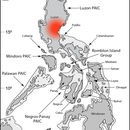en
names in breadcrumbs


Previous taxonomic assessments of species in this genus recognized six groups of species that shared similar morphologies (see Brown and Alcala, 1980). Subsequent analyses of morphology and phylogenetic studies have not supported the monophyly of these species groups, and large taxonomic revisions are needed in this diverse group of ground skinks to sort out the true species diversity and appropriate generic assignments of its members. This species has traditionally been considered a member of Group 3 species in the genus Sphenomorphus. Group 3 species were diagnosed on the basis of being small to intermediate sized, slender species that possess a number of scale characters in common (Brown and Alcala, 1980). Brown and Alcala (1980) also considered the Borneo species S. murudensis and S. kinabaluensis from Borneo as part of this group; however, Greer and Parker (1967) considered these species part of Group 4 or "variegatus" group.
In recent study of Philippine forest skinks, Linkem et al. (2011) used molecular data to test the monophyly of previously hypothesized species groups within the genus Sphenomorphus. Results of the study indicated widespread taxonomic instability, and as a result, broad taxonomic changes were made to the genus, resurrecting available names as well as describing new genera. Sphenomorphus leucospilos is now recognized to be a member of the genus Parvoscincus.
Parvoscincus leucospilos can be distinguished from congeners by the following combination of characters (1) medium body size (SVL 52.0–55.0 mm); (2) paravertebral scales 63–68; (3) midbody scales 30–32; (4) number of supraoculars contacting frontal 2 or 3; (5) Toe IV lamellae 16–18; (6) prefrontal scales in contact; (7) frontoparietal scales fused; (8) venter yellow.
Parvoscincus leucospilos is known from southern Luzon Island and the Sierra Madre Mountain Range of Luzon Island in the Philippines.
Luzon Pleistocene Aggregate Island Complex (PAIC; Brown and Diesmos, 2002).
SVL 52.0–55.0 mm
Luzon Island, Philippines; type in the Berlin Museum; ZMB 7467
Parvoscincus leucospilos, the white-spotted sphenomorphus, is a species of skink endemic to the Philippines. It is found between 300 and 1,200 m above sea levels in the forests of central and southern Sierra Madre Mountain Range (including Mount Banahaw) of Luzon Island.[1][2] This skink hides under rocks or in debris in the banks of streams and rivers. When threatened by predators, such as snakes, it may dive and stay under water for a long time.[3]
Parvoscincus leucospilos, the white-spotted sphenomorphus, is a species of skink endemic to the Philippines. It is found between 300 and 1,200 m above sea levels in the forests of central and southern Sierra Madre Mountain Range (including Mount Banahaw) of Luzon Island. This skink hides under rocks or in debris in the banks of streams and rivers. When threatened by predators, such as snakes, it may dive and stay under water for a long time.